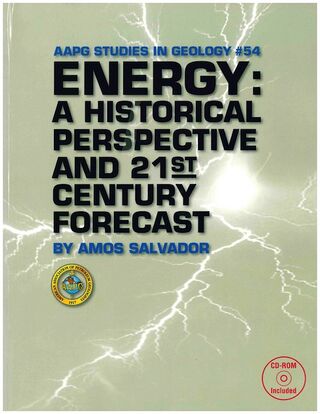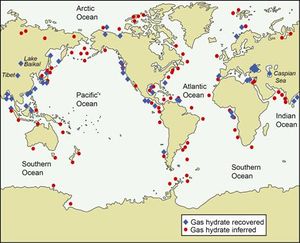Gas hydrates
| Energy: A Historical Perspective and 21st Century Forecast | |

| |
| Series | Studies in Geology |
|---|---|
| Chapter | Sources of Energy |
| Author | Dr. Amos Salvador |
| Link | Web page |
| PDF file (requires access) | |
Gas hydrates have been commonly mentioned as potentially vast sources of natural gas. The high cost and the technical, operational, and environmental problems of recovering gas from these reservoirs make them unlikely sources of gas for many years to come, certainly as long as cheaper, more readily produced sources of gas are available.

Gas hydrates (also called gas clathrates) are icelike, crystalline solids composed of natural-gas molecules, principally methane, trapped in rigid crystalline cages formed by frozen water molecules. They are known to be stable under conditions of high pressure and low temperature that have been recognized in polar regions at depths from 130 to 2000 m (425 to 6500 ft), where temperatures are low enough for the formation of permafrost, and in the uppermost part of deep-water sediments below the sea floor at depths of more than 100-1100 m (330-3600 ft).[1][2]
Most methane in gas hydrates is of microbial origin, although some is believed to be the result of thermogenic processes.[3][4][5] Kvenvolden[4][5] reports that the total worldwide amount of methane in gas hydrates is certainly large, but that all of the estimates that have been made are speculative and uncertain. He adds that
...a convergence of current ideas suggests that the amount of methane in gas hydrates worldwide is about 7 x 105 trillion cubic feet.[6]
If this estimate is correct, he states that
...the amound of methane carbon in gas hydrates is a factor of two larger than the carbon present in known fossil fuel deposits (coal, oil, and natural gas).[7]
He concludes, however, that
...because of unsolved technological problems in producing methane from gas hydrates . . . wide-scale recovery of methane from these substances probably will not take place until sometime in the 21st century.[8]
Other authors are less optimistic about the future availability of gas from gas hydrates, although it has been estimated[9] that 183 bcf of gas has been produced from gas hydrates in the Messoyakha field, in northern Siberia, since its discovery in 1968. The field produces from both hydrates and free-gas reservoirs. More recently, Collett[10][11] confirms that
...current estimates of the amount of gas in the world's marine and permafrost gas hydrates accumulations are in rough accord at about 20,000 trillion m3 (706,200 tcf).
Collett[11] agrees with Kvenvolden that
...significant to potentially insurmountable technical issues must be resolved before gas hydrates can be considered a viable option for affordable supplies of natural gas.
He adds that
...we likely will not see significant worldwide gas production from hydrates for the next 30-50 years.[12]
He may be too optimistic, considering the large volumes of conventional gas now available and to be added in the future.
See also
References
- ↑ Collett, T. S., 2001, Natural-gas hydrates: Resources of the twenty-first century?, in M. W. Downey et al., eds., Petroleum provinces of the twenty-first century: AAPG Memoir 74, p. 85-108.
- ↑ Collett, T. S., 2002, Energy resource potential of natural gas hydrates: AAPG Bulletin, v. 86, no. 11, p. 1971-1992.
- ↑ MacDonald, G. J., 1990, The future of methane as an energy resource: Annual Review of Energy, v. 15, p. 53-83.
- ↑ 4.0 4.1 Kvenvolden, K. A., 1993, A primer on gas hydrates, in D. G. Howell, ed., The future of energy gases: U.S. Geological Survey Professional Paper 1570, p. 270-291.
- ↑ 5.0 5.1 Kvenvolden, K. A., 1993, Gas hydrates as a potential energy resource-A review of their methane content, in D. G. Howell, ed., The future of energy gases: U.S. Geological Survey Professional Paper 1570, p. 555-561.
- ↑ Kvenvolden, K. A., 1993, Gas hydrates as a potential energy resource-A review of their methane content, in D. G. Howell, ed., The future of energy gases: U.S. Geological Survey Professional Paper 1570, p. 557.
- ↑ Kvenvolden, K. A., 1993, Gas hydrates as a potential energy resource-A review of their methane content, in D. G. Howell, ed., The future of energy gases: U.S. Geological Survey Professional Paper 1570, p. 559.
- ↑ Kvenvolden, K. A., 1993, A primer on gas hydrates, in D. G. Howell, ed., The future of energy gases: U.S. Geological Survey Professional Paper 1570, p. 279.
- ↑ Collett, T. S., 1993, Natural gas production from arctic gas hydrates, in D. G. Howell, ed., The future of energy gases: U.S. Geological Survey Professional Paper 1570, p. 299-311.
- ↑ Collett, T. S., 2001, Natural-gas hydrates: Resources of the twenty-first century?, in M. W. Downey et al., eds., Petroleum provinces of the twenty-first century: AAPG Memoir 74, p. 85, 103.
- ↑ 11.0 11.1 Collett, T. S., 2002, Energy resource potential of natural gas hydrates: AAPG Bulletin, v. 86, no. 11, p. 1971.
- ↑ Collett, T. S., 2002, Energy resource potential of natural gas hydrates: AAPG Bulletin, v. 86, no. 11, p. 1991.